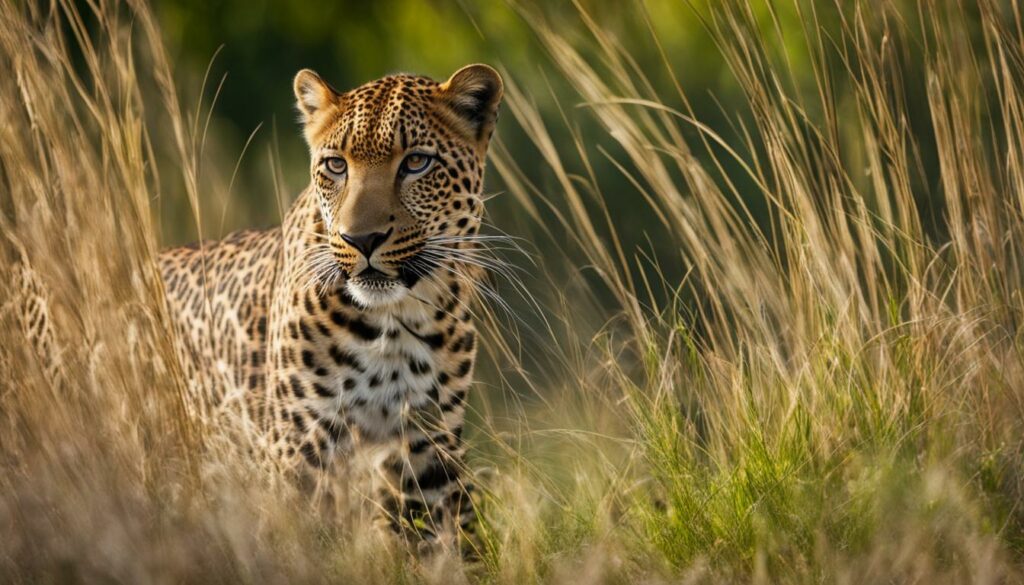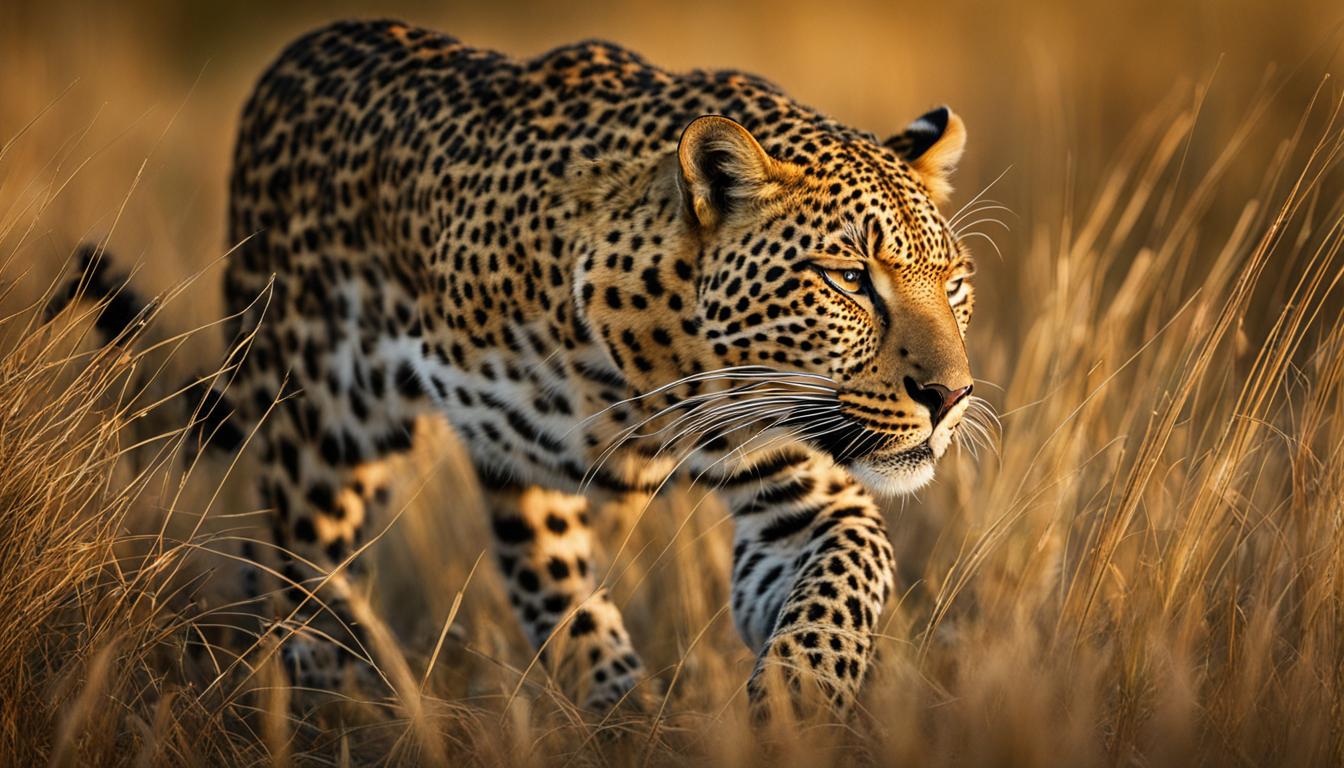If you’ve ever been curious about the diet and hunting habits of leopards, you’re in the right place. Leopards are fascinating creatures with a diverse menu that includes over 90 species. Their food habits are adaptable, allowing them to survive in various ecological settings. From antelopes to rodents, birds to dung beetles, leopards have a taste for it all.
Leopards are patient stalkers, relying on stealth and camouflage to ambush their prey. Their powerful jaws allow them to suffocate larger animals with a bite to the neck. This section will delve into their diet, prey selection, and hunting techniques. Let’s explore the world of leopards and uncover the secrets behind their incredible feeding habits.
Leopard Food Sources in Different Habitats
Leopards, with their diverse and adaptable diet, have a wide range of food sources that vary based on the habitat they live in. Let’s take a closer look at the specific food preferences of leopards in different environments.
Grasslands and Savannahs
In grassland and savannah habitats, leopards primarily hunt medium-sized ungulates such as antelopes, gazelles, and buffalos. These herbivores provide a substantial source of nutrition for leopards, ensuring their survival in these open landscapes.
Mountainous Regions
In mountainous regions, leopards adapt their diet to include animals that are well-suited to this challenging terrain. They prey on animals like porcupines, rodents, and rock hyraxes, using their climbing abilities to their advantage in pursuit of these smaller prey.
Rainforest Habitats
Within rainforest habitats, leopards have a preference for small antelopes and small primates as their main food source. Their agility and ability to navigate dense vegetation allow them to successfully hunt in these lush environments.
Island Habitats
On islands, leopards have a distinct food source – fish. Due to the absence of large terrestrial prey, leopards have adapted to rely on fishing as their primary means of sustenance in these unique settings.
Leopards showcase their remarkable ability to adjust their hunting techniques and food preferences based on the availability of prey in each specific habitat. This flexibility ensures their survival in diverse environments.
Table: Leopard Food Sources in Different Habitats
| Habitat | Food Sources |
|---|---|
| Grasslands and Savannahs | Antelopes, gazelles, buffalos |
| Mountainous Regions | Porcupines, rodents, rock hyraxes |
| Rainforest Habitats | Small antelopes, small primates |
| Island Habitats | Fish |
Leopard Dietary Requirements and Adaptations
Leopards have specific dietary requirements to meet their nutritional needs. Their diverse menu includes over 90 different species, allowing them to obtain a varied range of nutrients. While their preferred food sources are ungulates like antelope, gazelles, and impalas, they are also known to feast on baboons, hares, rodents, birds, lizards, porcupines, warthogs, fish, and even dung beetles. This adaptable feeding behavior ensures that leopards can survive in various ecological settings by adjusting their taste buds and hunting techniques.
In order to thrive in different environments, leopards have developed remarkable adaptations. One of their notable abilities is their strong climbing skills, which enables them to catch birds, their chicks, and even eggs in trees. This makes trees not only a place of rest, but also a strategic hunting ground for leopards. Additionally, leopards are patient stalkers and rely on stealth and camouflage to ambush their prey. With their powerful jaw muscles, they can suffocate larger animals by delivering a bite to the neck.
| Dietary Requirements | Adaptations |
|---|---|
| Leopards require a variety of animals in their diet to obtain necessary nutrients. | Leopards have developed strong climbing abilities, enabling them to catch birds, their chicks, and eggs in trees. |
| They adapt their hunting techniques and food preferences based on the availability of prey in each habitat. | Leopards are patient stalkers and rely on stealth and camouflage to ambush their prey. |
| With their powerful jaw muscles, they can suffocate larger animals by delivering a bite to the neck. |
In conclusion, leopards have specific dietary requirements and fascinating adaptations that allow them to successfully hunt and survive in different environments. Their ability to adjust their taste buds and hunting techniques, as well as their climbing skills and powerful jaw muscles, give them an advantage in obtaining a diverse range of prey and meeting their nutritional needs.
Leopards in Captivity and their Dietary Preferences
When it comes to leopards in captivity, their dietary preferences closely align with those of their wild counterparts. In confinement, they are typically provided with carrion sourced from local farms. This includes a variety of larger animals such as giraffes and antelopes, as well as livestock animals like cows and horses. To ensure their health and fitness, captive leopards require a varied diet that mirrors the nutrients found in their natural prey.
In order to maintain their well-being, it is crucial for captive leopards to be provided with a diet that replicates the diversity of their natural feeding habits. While carrion serves as the primary food source, it is supplemented with other options to meet their nutritional needs. This includes the inclusion of smaller prey such as rodents and birds, which contribute to a balanced diet.
It is worth noting that the captivity environment poses certain challenges for leopards, as they may not have the same opportunities for exercise and mental stimulation as their wild counterparts. Therefore, it is essential for caretakers to carefully monitor their feeding habits to prevent overfeeding and ensure their dietary requirements are met.
| Leopard Diet in Captivity | Captive Leopard Feeding Habits |
|---|---|
| Giraffes | Rodents |
| Antelopes | Birds |
| Cows | Carrion |
| Horses | Supplemented diet |
Table: Leopard Diet in Captivity and Captive Leopard Feeding Habits
How Much Do Leopards Eat and their Hunting Style
Leopards have a unique feeding pattern and do not need to consume food every day. After a substantial meal, they can go without hunting for 13 to 18 days. This adaptability allows them to survive in environments where food may be scarce at times. Their hunting style is characterized by patience, stealth, and precision.
Leopards are skilled stalkers and rely on their excellent camouflage to get close to their prey undetected. They carefully observe their surroundings, waiting for the perfect moment to pounce. With a powerful burst of speed, they sprint and deliver a swift bite to the neck, instantly disabling their target. This hunting technique ensures a quick and efficient kill, minimizing the risk of injury to the predator.
“The leopard is a master of stealth and surprise, utilizing its camouflage and agility to outsmart its prey. It patiently waits for the right moment to strike, ensuring a successful hunt with minimal effort.” – Dr. Jane Peterson, Wildlife Biologist
Leopards have the remarkable ability to take down prey larger than themselves. Their powerful jaw muscles enable them to suffocate and immobilize larger animals, such as antelopes and gazelles, with a bite to the neck. This strength and predatory adaptability allow them to thrive in various habitats, from grasslands to rainforests.
| Leopard Food Consumption | Estimated Amount |
|---|---|
| Antelope | 1-2 per week |
| Gazelle | 2-3 per week |
| Baboon | 1 per month |
| Warthog | 1 per week |
| Small mammals | Varies depending on availability |
Note: The table above provides estimated amounts as a representation of a leopard’s food consumption, taking into account the availability of their preferred prey and their irregular feeding patterns.
Leopard Food Competitors and Predators
Leopards, despite being skilled hunters, face fierce competition for food from other predators in their ecosystems. Lions, African wild dogs, and hyenas are known to prey on leopard cubs or steal their kills, posing a significant threat to their food sources. However, leopards have evolved strategies to minimize conflicts and avoid direct confrontation with larger predators. They primarily hunt alone and carefully select their hunting grounds to reduce the chances of encountering competitors.
In some cases, male leopards may resort to cannibalistic behavior, killing and eating younger leopards in order to decrease territorial competition and establish dominance over their territory and food sources. This brutal behavior ensures that the strongest and most capable leopards can thrive and maintain control over their hunting grounds.
Despite these challenges, leopards have managed to maintain their position in the food chain by adapting their hunting techniques and being opportunistic feeders. Their solitary nature and ability to adjust their hunting strategies based on the availability of prey help them survive and thrive even in the face of competition from other predators.
Table: Leopard Food Competitors
| Predator | Main Prey |
|---|---|
| Lions | Large and medium-sized ungulates |
| African Wild Dogs | Smaller ungulates and medium-sized mammals |
| Hyenas | Carrion, larger mammals, and smaller prey |
Note: This table highlights some of the main predators that compete with leopards for food. However, there may be other predators and scavengers that occasionally compete with leopards in specific regions or circumstances.
Fascinating Facts about Leopards and their Diet
Leopards are truly magnificent creatures with a range of interesting facts about their diet and behavior. Let’s dive into some fascinating insights about these elusive big cats.
Adaptability and Diversity
Leopards are known for their adaptability, which extends to their diet. As opportunistic hunters, their menu consists of over 90 species, making them one of the most diverse carnivores. From antelopes and gazelles to birds and fish, leopards have a wide-ranging palate that allows them to thrive in various habitats. This versatility in food choices enables leopards to adjust their taste buds and hunting techniques based on the availability of prey in each region.
Tree Climbers and Skilled Predators
Unlike other big cats, leopards have the remarkable ability to climb trees, which serves multiple purposes in their hunting strategy. They can rest in trees after capturing prey, keeping their meal safe from scavengers and other predators. Additionally, leopards use their climbing skills to catch birds and their chicks, as well as raid nests for eggs. This unique adaptation sets them apart from their feline counterparts and showcases their resourcefulness as skilled predators.
| Fact | Insight |
|---|---|
| Camouflage Masters | Leopards have a distinct fur coat with rosette-shaped spots, providing them with excellent camouflage in their natural habitat. |
| Nocturnal Lifestyle | Leopards are primarily nocturnal, meaning they are most active during the night, utilizing their excellent night vision to stealthily stalk their prey. |
| Solitary Nature | Leopards prefer a solitary lifestyle, maintaining territories to avoid competition with other individuals and ensuring a sufficient food supply. |
Leopards are truly remarkable creatures, adapting their diet and hunting techniques to thrive in diverse environments. Their climbing abilities, nocturnal lifestyle, and solitary nature contribute to their success as skilled predators in the animal kingdom.

Conclusion
Leopards have an incredibly diverse diet, allowing them to adapt to different habitats and survive in a changing environment. Their ability to hunt a wide range of prey species ensures they can meet their nutritional needs. From grasslands to rainforests, leopards have evolved various hunting techniques and food preferences based on their surroundings.
Understanding the dietary habits of leopards is essential for conserving their populations and protecting their natural habitats. By studying their food sources and nutritional requirements, we can develop effective conservation strategies to ensure their survival. It is crucial to preserve the ecosystems in which leopards thrive, as they play a vital role in maintaining the balance of their respective habitats.
As top predators, leopards have a significant impact on the ecosystem by regulating prey populations. Through their hunting behavior, they help prevent overpopulation of certain species, which can lead to habitat degradation. Conserving leopards not only benefits them but also contributes to the overall health and biodiversity of the ecosystems they inhabit.
How do the hunting techniques of cheetahs compare to leopards?
Cheetah diet and hunting techniques focus on speed and stealth, allowing them to chase down prey with incredible acceleration and agility. In contrast, leopards use a more patient approach, relying on their strength and powerful ambushes to catch their meals. Both predators have adapted their hunting strategies to suit their specific environments and prey.
FAQ
What do leopards typically eat?
Leopards have a diverse and adaptable diet, with over 90 species being part of their menu. They prefer ungulates like antelope, gazelles, and impalas, but also feast on baboons, hares, rodents, birds, lizards, porcupines, warthogs, fish, and even dung beetles.
How do leopards hunt?
Leopards are patient stalkers and rely on stealth and camouflage to ambush their prey. They use their powerful jaw muscles to suffocate larger animals with a bite to the neck.
What are the food sources of leopards in different habitats?
In grasslands and savannahs, leopards primarily hunt medium-sized ungulates like antelopes, gazelles, and buffalos. In mountainous regions, they feed on animals like porcupines, rodents, and rock hyraxes. In rainforest habitats, they prefer small antelopes and small primates. On islands, their diet predominantly consists of fish.
What are the dietary requirements of leopards?
Leopards consume a variety of animals to ensure they obtain all the necessary nutrients. They adjust their hunting techniques and food preferences based on the availability of prey in each habitat.
What do captive leopards eat?
In captivity, leopards are usually provided with carrion sourced from local farms, including larger animals like giraffes and antelopes, as well as livestock animals like cows and horses. Their dietary preferences are similar to their wild counterparts, as they still require the same nutrients found in their natural prey.
How frequently do leopards eat?
Leopards don’t feed every day and can go without hunting for 13 to 18 days after a big meal.
How do leopards hunt?
Leopards are patient and stealthy hunters. They stalk their prey and pounce from short distances, delivering a swift bite to the neck to immobilize their target. Their hunting choices are adaptable, and they adjust their techniques depending on the size and behavior of their prey.
What predators compete with leopards for food?
Leopards face competition for food from other predators such as lions, African wild dogs, and hyenas. These animals may prey on leopard cubs or steal their kills. However, leopards mainly hunt alone and will avoid stealing from larger predators to minimize conflicts.
What are some fascinating facts about leopards and their diet?
Leopards are highly adaptable and can be found in various habitats across Africa and Asia. They have a distinct fur coat with rosette-shaped spots. Leopards are skilled climbers and have a solitary nature. In the wild, they live for about 12 to 15 years, while in captivity, they can live up to 23 years.











